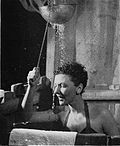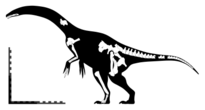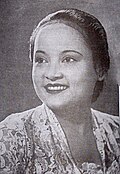
Back Wikipédia:Lumière sur/Avril 2020 French Wikipedia:Bài viết chọn lọc/2020/04 Vietnamese Wikipedia:典范条目/2020年4月 Chinese
| << | Today's featured articles for April 2020 | >> | ||||
|---|---|---|---|---|---|---|
| Su | Mo | Tu | We | Th | Fr | Sa |
| 1 | 2 | 3 | 4 | |||
| 5 | 6 | 7 | 8 | 9 | 10 | 11 |
| 12 | 13 | 14 | 15 | 16 | 17 | 18 |
| 19 | 20 | 21 | 22 | 23 | 24 | 25 |
| 26 | 27 | 28 | 29 | 30 | ||
April 1
Tirpitz was the second of two Bismarck-class battleships built for Nazi Germany during World War II. The ship was laid down in November 1936 and commissioned in February 1941. Tirpitz was armed with a main battery of eight 38-centimetre (15 in) guns in four twin turrets. She was the heaviest battleship ever built by a European navy. In early 1942, the ship sailed to Norway to act as a fleet in being, forcing the British navy to retain significant forces in the area. In September 1943, Tirpitz, along with the battleship Scharnhorst, bombarded Allied positions on Spitzbergen, the only time the ship's main battery was used offensively. On 12 November 1944, British Lancaster bombers equipped with 12,000-pound (5,400 kg) "Tallboys" bombed the ship, causing her to capsize. A deck fire spread to an ammunition magazine causing a large explosion. Between 1948 and 1957, the wreck was broken up in a salvage operation. (This article is part of a featured topic: Battleships of Germany.)
April 2
Hathor was a major goddess in ancient Egyptian religion. As a sky deity, she was the mother or consort of the sky god Horus and the sun god Ra, and the symbolic mother of their earthly representatives, the pharaohs. She was one of several goddesses who acted as the Eye of Ra, Ra's feminine counterpart, and in this form she had a vengeful aspect that protected him from his enemies. Her beneficent side represented music, dance, joy, love, sexuality and maternal care. These two aspects of the goddess exemplified the Egyptian conception of femininity. Hathor crossed boundaries between worlds, helping deceased souls in the transition to the afterlife. She was often depicted as a cow, although her most common form was a woman wearing a headdress of cow horns and a sun disk. More temples were dedicated to her than to any other goddess; her most prominent temple was Dendera. She was one of the deities commonly invoked in private prayers and votive offerings, particularly by women desiring children. (Full article...)
April 3
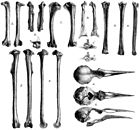
The Rodrigues starling (Necropsar rodericanus) is an extinct species of starling that was endemic to the Mascarene island of Rodrigues. Its closest relatives were the Mauritius starling and the hoopoe starling from nearby islands. The bird was reported by a French sailor Julien Tafforet, who was marooned on the island from 1725 to 1726. He observed it on the offshore islet of Île Gombrani. Subfossil remains (pictured) from the mainland were described in 1879, and suggested to be of the same species. Confusion about the bird and its taxonomic relations persisted through the 20th century. This starling was 25–30 centimetres (10–12 inches) long, and had a stout beak. It was described as having a white body, partially black wings and tail, and a yellow bill and legs. Little is known about its behaviour, although its diet included eggs and dead tortoises. Predation by rats introduced to the area was probably responsible for the bird's extinction some time in the 18th century, first on mainland Rodrigues, then on Île Gombrani. (Full article...)
April 4
When You Get a Little Lonely is a studio album by American actor and singer Maureen McCormick (pictured), her only solo album, released on April 4, 1995, through the label Phantom Hill. While playing Marcia Brady in the sitcom The Brady Bunch in the 1970s, McCormick recorded four albums with the cast and a duet album with her co-star Christopher Knight. In 1994, she signed with her brother's record label and recorded When You Get a Little Lonely in Nashville, Tennessee, and Hollywood, California. McCormick selected the final track listing, fusing other genres into the album's overall country sound. Barry Coffing was the executive producer, and arranged and produced all the songs. The title track and "Tell Mama" were released as singles. The album received mainly negative reviews. Since its release, McCormick has continued to perform country music and has appeared on the reality television show Gone Country. (Full article...)
April 5
Adventure Time is an American fantasy animated television series created by Pendleton Ward for Cartoon Network. The series follows the adventures of a boy named Finn, voiced by Jeremy Shada (pictured), and his best friend Jake, a dog who can change shape and size at will, voiced by John DiMaggio. In the post-apocalyptic Land of Ooo, they interact with Princess Bubblegum (Hynden Walch), the Ice King (Tom Kenny), Marceline (Olivia Olson), and others. The series is based on a 2007 short for Nicktoons and Frederator Studios' Random! Cartoons. Premiering April 5, 2010, and ending September 3, 2018, each 11-minute episode took roughly 8–9 months to complete using hand-drawn animation. Adventure Time was a ratings success for Cartoon Network with up to three million viewers. It has received positive reviews from critics and won eight Primetime Emmy Awards, a Peabody Award, three Annie Awards, and two British Academy Children's Awards. Four Adventure Time specials will air on HBO Max starting in 2020. (Full article...)
April 6
Operation Retribution was the April 1941 German bombing of Belgrade, the capital of the Kingdom of Yugoslavia, in retaliation for the coup d'état that overthrew the government that had signed the Tripartite Pact. The bombing occurred in the first days of the invasion of Yugoslavia by German-led Axis forces during World War II. The Royal Yugoslav Army Air Force had only 77 modern fighter aircraft available to defend Belgrade against the hundreds of German fighters and bombers that struck in the first wave early on 6 April. Three days prior, Major Vladimir Kren had defected to the Germans, divulging the air force's codes and disclosing the locations of military assets. Three more waves of bombers attacked Belgrade on 6 April, and more attacks followed in subsequent days. The attacks resulted in the paralysis of Yugoslav civilian and military command and control, the widespread destruction of Belgrade's infrastructure, and many civilian casualties. (Full article...)
April 7
South Pacific is a musical composed by Richard Rodgers, with lyrics by Oscar Hammerstein II and book by Hammerstein and Joshua Logan. The work was an immediate hit on Broadway in 1949, running for 1,925 performances and winning the Pulitzer Prize for Drama. The plot is based on several stories in James A. Michener's Pulitzer Prize–winning 1947 book Tales of the South Pacific. Rodgers and Hammerstein believed that the musical could be successful and send a strong progressive message on racism. They wrote several of the songs with the particular talents of their stars, Ezio Pinza and Mary Martin, in mind. Most of its songs became popular, including "Some Enchanted Evening" and "I'm Gonna Wash That Man Right Outa My Hair" (performance pictured). The original Broadway production won ten Tony Awards, including Best Musical; its original cast album was the bestselling record of the 1940s. The show has enjoyed many successful revivals and tours, spawning a 1958 film and later television adaptations. (Full article...)
April 8
Gerard (died 1108) was Archbishop of York between 1100 and 1108 and Lord Chancellor of England from 1085 until 1092. A Norman, he was a member of the cathedral clergy at Rouen before becoming a royal clerk under King William I of England, who appointed him Lord Chancellor. He continued in that office under King William II Rufus, who rewarded him with the Bishopric of Hereford in 1096. Soon after Henry I's coronation, Gerard was appointed to the recently vacant see of York, and became embroiled in the dispute between York and the see of Canterbury concerning which archbishopric had primacy over England. He secured papal recognition of York's jurisdiction over the church in Scotland but was forced to accept Canterbury's authority over York. He also worked on reconciling the Investiture Controversy between the king and the papacy over the right to appoint bishops until the controversy's resolution in 1107. Because of rumours, as a student of astrology, that he was a magician and a sorcerer, and also because of his unpopular attempts to reform his clergy, he was denied a burial inside York Minster but his remains were later moved into the cathedral. (Full article...)
April 9
Fir Clump Stone Circle was an ancient monument in Burderop Wood near Wroughton, Wiltshire, in South West England. It was one of at least seven stone circles known to have been built in northern Wiltshire south of Swindon, but none of them remain. The ring was part of a tradition of stone circle construction that spread throughout much of Britain, Ireland and Brittany during the Late Neolithic and Early Bronze Age, between 3300 and 900 BCE. The purpose of such monuments is unknown, although archaeologists speculate that the stones represented supernatural entities. Around the 1860s, the megaliths in Fir Clump Stone Circle were levelled, but some of them were rediscovered in 1965 by the archaeologist Richard Reiss, who described and measured the monument. In 1969, these stones were removed during construction of the M4 motorway. (Full article...)
April 10
Hygrophoropsis aurantiaca, the false chanterelle, is a species of fungus in the family Hygrophoropsidaceae. It is found across several continents, growing in woodland and heathland, and sometimes on woodchips used in gardening and landscaping. Its mushrooms are yellow-orange with a funnel-shaped cap up to 8 cm (3+1⁄8 in) across that has a felt-like surface. The thin, often forked gills on the underside of the cap run partway down the length of the otherwise smooth stalk. The mushroom can be mildly poisonous. Austrian naturalist Franz Xaver von Wulfen described the false chanterelle in 1781, noting both its resemblance to the true chanterelles and people's propensity to confuse them. The false chanterelle was then placed in the genus Clitocybe, but it was later observed that its forked gills and dextrinoid spores indicated a relationship to Paxillus. Genetic analysis has confirmed that it belongs to the order Boletales and is more closely related to boletes. (Full article...)
April 11
Apollo 13 (April 11–17, 1970) was the seventh crewed mission in the Apollo space program and the third meant to land on the Moon. The landing was aborted after an oxygen tank in the service module (pictured) failed two days into the mission. Apollo 13 was commanded by Jim Lovell with Jack Swigert as command module (CM) pilot and Fred Haise as lunar module (LM) pilot. Swigert was a late replacement for Ken Mattingly, who was grounded after exposure to rubella. After the explosion, the CM's systems had to be shut down to conserve resources, forcing the crew to transfer to the LM as a lifeboat. Although the LM was designed to support two men for two days, Mission Control improvised new procedures so it could support three men for four days. The astronauts' peril briefly renewed interest in the Apollo program; tens of millions watched the splashdown in the South Pacific Ocean by television. The story of Apollo 13 has been dramatized, most notably in the 1995 film Apollo 13. (Full article...)
April 12
Segnosaurus is a genus of large-bodied therizinosaurid dinosaurs that lived during the Late Cretaceous period. Discovered in the Gobi Desert in southeastern Mongolia in the 1970s, incomplete but well-preserved specimens included the lower jaw, neck and tail vertebrae, the pelvis, the shoulder girdle, and limb bones. Parts of the specimens have since gone missing or become damaged. Named in 1979, Segnosaurus ('slow lizard') is estimated to have been about 6–7 m (20–23 ft) long and to have weighed about 1.3 metric tons (1.4 short tons). It was bipedal, with the trunk of its body tilted upwards. The head was small with a beak at the tip of the jaws, and the neck was long and slender, adapted to browsing. The forelimbs were robust, with three-fingered hands bearing large claws, and the feet had four toes. The pubic bone was turned backwards, as in birds. Segnosaurus and its relatives are thought to have been mainly herbivorous, unlike most other theropods, and slow-moving. (Full article...)
April 13
Andha Naal (That Day) is a 1954 Indian Tamil-language mystery-thriller film, produced by A. V. Meiyappan and directed by S. Balachander (pictured). It is the first film noir in Tamil cinema, and the first Tamil film made without songs, dancing, or stunt sequences. It is set in Madras during World War II; after a radio engineer Rajan (Sivaji Ganesan) is killed, each suspect's account points to a new suspect. The film developed from a play script that Balachander wrote, adapting the narrative style of Akira Kurosawa's Rashomon. The screenplay was written by Javar Seetharaman, and cinematography was handled by S. Maruti Rao. Released on 13 April 1954, the eve of Tamil New Year, the film was initially a commercial failure, but it was re-released after winning a Certificate of Merit in 1955 at the National Film Awards and became a box-office success. In 2013, Andha Naal was included in CNN-News18's list of the "100 Greatest Indian Films of All Time". (Full article...)
April 14

with a captured Hitler Youth flag
The Razing of Friesoythe took place on 14 April 1945 towards the end of World War II. The 4th Canadian (Armoured) Division, advancing into north-west Germany, attacked the German-held town of Friesoythe. The Argyll and Sutherland Highlanders of Canada captured the town. During the fighting the battalion's commander was killed by a German soldier, but it was reported that he had been killed by a civilian. The division's commander, Major-General Christopher Vokes, ordered that the town be razed in retaliation, and it was substantially destroyed. Twenty German civilians died in Friesoythe during the fighting. The rubble of the town was used to fill craters in local roads to make them passable for the division's tanks and heavy vehicles. Little official notice was taken of the incident and the Canadian Army official history glosses over it. Forty years later, Vokes wrote in his autobiography that he had "no great remorse over the elimination of Friesoythe". (Full article...)
April 15
Horologium is a constellation of six faintly visible stars in the southern celestial hemisphere. It was first described by the French astronomer Nicolas-Louis de Lacaille in 1756 and visualized by him as a clock with a pendulum and a second hand. The boundaries of Horologium (literally 'an instrument for telling the hour') were specified in 1922 by the International Astronomical Union, and it has since been one of their designated constellations. All parts of the constellation are visible to observers south of 23°N. The constellation's brightest star – and the only one brighter than an apparent magnitude of 4 – is Alpha Horologii (at 3.85), an ageing orange giant star that has swollen to around 11 times the diameter of the Sun. The long-period variable-brightness star, R Horologii (4.7 to 14.3), has one of the largest variations in brightness known for stars in the night sky visible to the unaided eye. Four star systems in the constellation are known to have exoplanets; one – Gliese 1061 – contains an exoplanet in its habitable zone. (Full article...)
April 16
Vision in White is the first book of the Bride Quartet series of romance novels, written by Nora Roberts (pictured). After its April 2009 release, it spent two weeks atop one of the New York Times bestseller lists and reached number three on the USA Today bestseller list. In her career, Roberts has published more than 225 novels. Vision in White was one of ten Roberts novels published in 2009, including five new releases and five reprints. It marked her return to contemporary romance. Like several other Roberts novels, Vision in White explores how a protagonist balances a successful career with a dysfunctional family environment. The hero is a typical representation of the romance novel archetype of the professor, but in an unusual twist for a romance novel, he is the character who is ready for a commitment but must help the heroine overcome her fears. A downloadable casual-play computer game based on the book was introduced by I-Play in 2010. (Full article...)
April 17
The Abbasid invasion of Asia Minor in 806 CE was an attack by the Abbasid Caliphate against the Byzantine Empire in southeastern and central Asia Minor. Soon after his accession in 802, the Byzantine emperor Nikephoros I ceased paying tribute to the Caliphate and attacked it. In retaliation, Harun al-Rashid, the Abbasid caliph, invaded Byzantium with a force far larger than any seen before. The Abbasid army met no opposition and raided at will, capturing several towns and fortresses, including Herakleia, whose fall was celebrated by the Caliph's propaganda. Nikephoros was forced to seek peace and resume paying tribute. Harun exacted a personal tax on the Emperor and his heir, Staurakios, as a token of their submission and withdrew. Almost immediately Nikephoros violated the peace terms, but Harun's preoccupation with a rebellion prevented reprisal. Harun's death, the Abbasid civil war, and Nikephoros' Bulgarian wars prevented the resumption of large-scale warfare for two decades. (Full article...)
April 18
William Bonville, 1st Baron Bonville (1392–1461), was a powerful landowner in southwest England. Undertaking royal service, he fought in France in the later years of the Hundred Years' War. In 1415, he joined the English invasion of France in the retinue of Thomas, Duke of Clarence, Henry V's brother, and fought on the Agincourt campaign. In 1437, King Henry VI granted Bonville the profitable office of steward of the Duchy of Cornwall, passing over and enraging Bonville's powerful neighbour Thomas Courtenay, Earl of Devon. His dispute with Bonville descended into violence, and the feud continued intermittently for the next decade. In 1453, Henry became ill and entered a catatonic state for eighteen months; Bonville generally seems to have remained loyal to the king, although his guiding motivation was to support whoever would aid him in his feud. In 1461, he took part on the losing side in the Second Battle of St Albans during the Wars of the Roses and was beheaded for it. (Full article...)
April 19
The giant mouse lemurs (genus Mirza) are primates native to Madagascar, like all other lemurs. The two described species, the northern (pictured) and Coquerel's giant mouse lemurs, are found in the western dry deciduous forests, Sambirano valley and Sahamalaza Peninsula. In 1870, British zoologist John Edward Gray assigned them to Mirza, but the classification was not widely accepted until the 1990s, following the revival of the genus by American paleoanthropologist Ian Tattersall in 1982. Giant mouse lemurs weigh approximately 300 g (11 oz) and have a long, bushy tail. They sleep in nests during the day and forage alone at night for fruit, tree gum, insects, and small vertebrates. The northern species has the largest testicles relative to body size of any living primate. Predators of giant mouse lemurs include the Madagascar buzzard, Madagascar owl, fossa, and narrow-striped mongoose. Both Mirza species are endangered due to habitat destruction and hunting. (Full article...)
April 20
Userkaf was a pharaoh of ancient Egypt and the founder of the Fifth Dynasty. Before ascending the throne, he may have been a high priest of Ra. He reigned for seven to eight years in the early 25th century BC, during the Old Kingdom period. He built a sun temple, known as the Nekhenre, that mainly functioned as a mortuary temple associated with the setting sun. Rites performed in the temple were primarily concerned with Ra's creator function and his role as father of the king. Userkaf built a pyramid in Saqqara, close to that of Djoser, with a mortuary temple that was much smaller than those built during the Fourth Dynasty. Its mortuary complex was lavishly decorated with fine painted reliefs. Little is known of Userkaf's activities beyond the construction of his pyramid and sun temple. There may have been a military expedition to Canaan or the Eastern Desert, and there probably were trade contacts with the Aegean civilizations. (Full article...)
April 21
Djaoeh Dimata (Out of Sight) is a 1948 film from what is now Indonesia, written and directed by Andjar Asmara for the South Pacific Film Corporation (SPFC). Starring Ratna Asmara (pictured) and Ali Joego, it follows a woman who goes to Jakarta to find work after her husband is blinded in an accident. She becomes a singer and achieves wide acclaim, but eventually returns home. SPFC's first production, Djaoeh Dimata took two to three months to film and cost almost 130,000 gulden. The first domestically produced feature film to be released in five years, Djaoeh Dimata received favourable reviews, although financially it was outperformed by Roestam Sutan Palindih's Air Mata Mengalir di Tjitarum (released soon after). The film's cast remained active in the Indonesian film industry, some for another thirty years, and SPFC produced six more works before closing in 1949. A copy of the film is stored at Sinematek Indonesia. (Full article...)
April 22
Henry Conwell (c. 1748 – 1842) was an Irish-born Catholic bishop in the United States. After serving as a priest in Ireland for more than four decades, he was installed as the second bishop of Philadelphia in 1819. He took up the post at an advanced age, and spent much of his time there feuding with the lay trustees of his parishes, especially those of St. Mary's Church in Philadelphia. When he removed and excommunicated William Hogan, a controversial priest at St. Mary's, the parish trustees instead rejected Conwell's authority, creating a minor schism. The two sides partially reconciled by 1826, but the Vatican hierarchy believed Conwell had ceded too much power to the laymen and recalled him to Rome. Although he retained his position, he was compelled to relinquish actual control to his coadjutor bishop, Francis Kenrick. He remained in Philadelphia and performed some priestly duties, but for all practical purposes no longer ran the diocese. (Full article...)
April 23

The 1927 FA Cup Final was an association football match between Cardiff City and Arsenal on 23 April 1927 at the Empire Stadium (pictured), the original Wembley Stadium. With 91,206 in attendance, the final was the showpiece match of English football's primary cup competition, the Football Association Challenge Cup. A concert held before the game included "Abide with Me"; singing this song before the match has since become a cup final tradition. For the first time, the final was broadcast on the radio by the BBC. Cardiff, one of the few Welsh teams taking part in the cup competition, won the match 1–0; the goal was credited to Hughie Ferguson after his shot slipped out of the hands of Arsenal goalkeeper Dan Lewis. The victory remains the only occasion the trophy, which was previously known as the "English Cup", has been won by a team based outside England. Cardiff did not reach the FA Cup final again until 2008. (Full article...)
April 24
James Wood Bush (c. 1844 – 1906) was an American Union Navy sailor of British and Native Hawaiian descent. He was among a group of more than one hundred Native Hawaiian and Hawaii-born combatants in the Civil War, at a time when the Kingdom of Hawaii was still an independent nation. Enlisting in the Union Navy in 1864, Bush served as a sailor aboard the USS Vandalia (depiction shown) and the captured Confederate vessel USS Beauregard, which maintained the blockade of the ports of the Confederacy. He was discharged from service in 1865 after an injury, which developed into a chronic condition in later life. Returning to Hawaii in 1877, he worked as a government tax collector and road supervisor for the island of Kauai, where he settled down. After the annexation of Hawaii to the United States, Bush was recognized for his military service, and in 1905 was granted a government pension for the injuries he received in the Navy. (Full article...)
April 25
The Morgan Black Hours is an illuminated book of hours produced in Bruges between 1460 and 1480. It is one of seven surviving black books of hours, all originating from Bruges and dated to the mid- to late 15th century. They are named for their unusual dark blueish colourisation, achieved through the expensive process of dyeing the vellum with iron gall ink. The Morgan Black Hours consists of 121 leaves, most containing rows of Latin text written in Gothic minuscule script inscribed in silver and in gold. The pages are typically dyed a deep blueish black, with borders ornamented with flowers, foliage and grotesques. Although considered a masterpiece of Late Gothic manuscript illumination, there are no surviving records of its commission, but its dark tone, expense of production, quality and rarity suggest ownership by privileged and sophisticated members of the Burgundian court. It has been in the collection of the Morgan Library & Museum in New York since 1912. (Full article...)
April 26
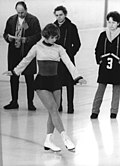
Compulsory figures were formerly a segment of figure skating, from which the sport derives its name. Requiring skaters to trace precise circles while completing difficult turns and edges, these exercises made up 60 percent of the total score at most competitions around the world until 1947. The simple figure-eight shape was executed by connecting two circles; other figures included the three turn, the counter turn, the rocker turn, the bracket turn, and the loop. Compulsory figures steadily declined in importance, and in 1990 the International Skating Union voted to discontinue them as a part of competitions. Although few skaters continue to practice them, some skaters and coaches continue to use them to develop alignment, core strength, body control, and discipline. Since 2015, the World Figure Sport Society has conducted festivals and competitions of compulsory figures, endorsed by the Ice Skating Institute. (Full article...)
April 27
The black honeyeater (Sugomel niger) is a species of bird in the honeyeater family, Meliphagidae. The bird exhibits sexual dimorphism: the males are black and white, while the females and immature birds are a speckled grey-brown. The species is endemic to Australia, and ranges widely across the arid areas of the continent, through open woodland and shrubland. A nectar feeder, the black honeyeater has a long curved bill to reach the base of tubular flowers such as those of the emu bush. It also takes insects in the air, and regularly eats ash left behind at campfires. Cup-shaped nests are built in the forks of small trees or shrubs. The male engages in a soaring song flight in the mating season, but contributes little to nest building or incubating the clutch of two to three eggs. Both sexes feed and care for the young. While the population appears to be decreasing, the black honeyeater is numerous and widespread. (Full article...)
April 28
Alf Ramsey (22 January 1920 – 28 April 1999) was an English football player and manager. As England manager from 1963 to 1974, he guided them to victory in the 1966 FIFA World Cup. Knighted in 1967, he also managed his country to third place in the 1968 European Championship and the quarter-finals of the 1970 World Cup and the 1972 European Championship. As a player, he was a defender and a member of England's 1950 World Cup squad, and a part of the Tottenham Hotspur side that won the English League championship in the 1950–51 season. A statue of Ramsey was dedicated at the reconstructed Wembley Stadium in 2009, and various honours have been afforded to him for his eight years as Ipswich Town manager. He is the first person to be inducted twice into the English Football Hall of Fame: in 2002 in recognition of his achievements as a manager, and again in 2010 for his achievements as a player. He remains widely regarded as one of British football's all-time great managers. (Full article...)
April 29
The Hudson Sesquicentennial half dollar is a fifty-cent piece struck by the United States Bureau of the Mint in 1935 as a commemorative coin. The coin was designed by Chester Beach. Its obverse depicts the Half Moon, flagship of Henry Hudson, after whom the city of Hudson is named. In addition to showing the ship, the coin displays a version of the Hudson city seal, with Neptune riding a whale, a design that has drawn commentary. Although the city of Hudson was a relatively small municipality, legislation to issue a coin in honor of its 150th anniversary went through Congress without opposition and was signed by President Franklin D. Roosevelt, becoming the Act of May 2, 1935. Most of the coins were likely bought by coin dealers, leaving few for collectors, with the result that prices spiked from the $1 cost at the time of issue. This caused collector anger, but did not lower the coin's value, which has continued to increase in the 80-plus years since it was struck. (Full article...)
April 30
Isopogon anemonifolius is a shrub of the family Proteaceae which is native to eastern New South Wales in Australia. It occurs naturally in woodland, open forest, and heathland on sandstone soils. Described in 1796 by Richard Salisbury, I. anemonifolius usually ranges between 1 and 1.5 metres (3+1⁄4 and 5 feet) in height, generally being smaller in exposed heathland. Its leaves are divided and narrow, though broader than those of the related Isopogon anethifolius, and have a purplish tinge during the cooler months. The yellow flowers appear during late spring or early summer and are displayed prominently. They are followed by round grey cones, which give the plant its common name drumsticks. The small hairy seeds are found in the old flower parts. A long-lived plant (up to 60 years), I. anemonifolius resprouts from its woody base after bushfire. It grows readily in the garden if located in a sunny or partly shaded spot with sandy soil and good drainage. (Full article...)





